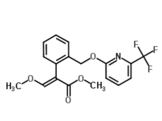
Empirical formula: C18H16F3NO4
Mol. Weight: 367.3
CAS No.: 117428-22-5
Specifications:
Leading Picoxystrobin supplier
Picoxystrobin 95%TC,
Picoxystrobin 97% TC,
Picoxystrobin 97% TC,
Picoxystrobin 250g/L SC ,
Picoxystrobin 225g/L SC,
Packing:
BULK PACKING
Powder: 25KG/Bag, 25KG/Drum, 50KG/Drum etc.
Liquid: 200L/Drum, 20L/Drum, 10L/Drum ect.
SMALL PACKING
Powder: 1kg/Alu bag, 500g/Alu bag, 200g/Alu bag, 100g/Alu bag, 50g/Alu bag, 15g/Alu bag etc.
Liquid: 5L/Drum, 1L/Bottle, 500ml/Bottle, 250ml/Bottle, 100ml/Bottle, 50ml/Bottle etc.
Customerized Packing label
Picoxystrobin FAO standard
Professional registration
HAZARDS IDENTIFICATION:
GHS Hazard statement(s)
H319 (53.06%): Causes serious eye irritation [Warning Serious eye damage/eye irritation]
H332 (100%): Harmful if inhaled [Warning Acute toxicity, inhalation]
H400 (100%): Very toxic to aquatic life [Warning Hazardous to the aquatic environment, acute hazard]
H410 (76.53%): Very toxic to aquatic life with long lasting effects [Warning Hazardous to the aquatic environment, long-term hazard]
Information may vary between notifications depending on impurities, additives, and other factors. The percentage value in parenthesis indicates the notified classification ratio from companies that provide hazard codes. Only hazard codes with percentage values above 10% are shown.
MAMMALIAN TOXICOLOGY
Acute toxicity: 1) Acute oral LD50 for rats >5000 mg/kg; 2) Acute percutaneous LD50 for rats >2000 a.i.mg/kg. 3) Acute inhalation toxicity LC50 (4h) for rats: >3.19 a.i. mg/L; 4) Skin irritation: Not an irritant (rabbits). 5) Eye irritation for rabbit: slightly irritating; 6) Skin sensitization for guinea pig: not a sensitize.
ADI (JMPR) 0.09 mg/kg b.w. [2012].
Classification:
EC Risk Classification:Xn-Harmful: R20, N-Dangerous for the environment: R50/53
ECOTOXICOLOGY
Effect on birds: low toxicity to birds, Acute LD50 for Japanese quail is >2250 a.i. mg/kg. Effects on Fish: moderate to high toxicity to fish, Acute LC50 (96h) for rainbow trout is 0.075 a.i.mg/L. Effects on Aquatic invertebrates: hight toxicity to Aquatic invertebrates, Acute LC50 (48h) for daphnia magan is 0.024 a.i.mg/L. Effects on Algae: moderate toxicity to algae, Acute hour EC50 (72h), growth for Raphidocelis subcapitata is 0.056 a.i. mg/L. Effects on Bees: low to honeybee. Contact acute LD50 (48h) is >200 a.i.μg/bee, Oral acute LD50 (48h) is 0.09 a.i.μg/bee. Effects on earthworms: high toxic to earthworms, Acute 14 day LC50 3.4 a.i. mg/kg.
ENVIRONMENTAL FATE
Picoxystrobin is applied to foliage where it rapidly penetrates and is rainfast after two hours. The fraction that is not intercepted by foliage and lands on the soil will be microbially degraded under aerobic conditions with a halflife ranging from 30 to 74 days. It is also degraded on soil by photolysis, with a half life of 12 days; however, photolysis both on soil and in water is limited by the degree of exposure to light. It is ranked as moderately mobile to mobile in soil, but is not generally detected below a depth of 5 cm. With a log Kow of 3.6, it is expected to bind to organic carbon in soil and sediment. Ten field dissipation studies were conducted, two in U.S. soils, two in Canadian soils, and six in European soils. The DT50 ranged from a low of 35 days in Wisconsin sandy loam-loamy soil to a high of 151 days in clay loam-loam soil in Manitoba, Canada. The geometric mean of the DT50s for the ten field dissipation studies was 67 days. In water, picoxystrobin is degraded slowly by photolysis, with a half life of about 29 days. It is stable to hydrolysis. In an aerobic water-sediment system studies, picoxystrobin was degraded with a half life for the total system ranging from 39 to 48 days. Under anaerobic aquatic conditions, the half life was about 84 days for the total system.
Usage: Picoxystrobin is a fungicide belonging to the strobilurin group of chemicals and developed in Syngenta company with preventive, curative and systemic activity for use canola, cereal graints (no rice), dried peas, corn and soybeans.
Application: Picoxystrobin is currently using the best effect of methoxyl acrylic ester fungicide,The foliar diseases prevention and control of wheat and barley,Such as leaf blight, leaf rust, clever blight, leaf spot, powdery mildew, etc.Methoxyl acrylic ester disinfectant is a kind of low toxicity, high efficiency, broad spectrum and systemic bactericide,Almost all of fungi Diseases such as powdery mildew, rust, clever blight, mesh spot, downy mildew, blast, etc all have good activity,And can effectively control the other fungicide resistant pathogens,Protective effect, treatment and eradication, osmosis, no carcinogenic and mutagenic characteristics,Picoxystrobin belong to systemic broad-spectrum fungicide, rooting out, protection, penetration and absorption effect.







